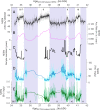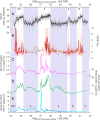Sea ice fluctuations in the Baffin Bay and the Labrador Sea during glacial abrupt climate changes
- PMID: 36279448
- PMCID: PMC9636944
- DOI: 10.1073/pnas.2203468119
Sea ice fluctuations in the Baffin Bay and the Labrador Sea during glacial abrupt climate changes
Abstract
Sea ice decline in the North Atlantic and Nordic Seas has been proposed to contribute to the repeated abrupt atmospheric warmings recorded in Greenland ice cores during the last glacial period, known as Dansgaard-Oeschger (D-O) events. However, the understanding of how sea ice changes were coupled with abrupt climate changes during D-O events has remained incomplete due to a lack of suitable high-resolution sea ice proxy records from northwestern North Atlantic regions. Here, we present a subdecadal-scale bromine enrichment (Brenr) record from the NEEM ice core (Northwest Greenland) and sediment core biomarker records to reconstruct the variability of seasonal sea ice in the Baffin Bay and Labrador Sea over a suite of D-O events between 34 and 42 ka. Our results reveal repeated shifts between stable, multiyear sea ice (MYSI) conditions during cold stadials and unstable, seasonal sea ice conditions during warmer interstadials. The shift from stadial to interstadial sea ice conditions occurred rapidly and synchronously with the atmospheric warming over Greenland, while the amplitude of high-frequency sea ice fluctuations increased through interstadials. Our findings suggest that the rapid replacement of widespread MYSI with seasonal sea ice amplified the abrupt climate warming over the course of D-O events and highlight the role of feedbacks associated with late-interstadial seasonal sea ice expansion in driving the North Atlantic ocean-climate system back to stadial conditions.
Keywords: Baffin Bay; Dansgaard-Oeschger events; Labrador Sea; abrupt climate changes; sea ice reconstruction.
Conflict of interest statement
The authors declare no competing interest.
Figures





References
-
- Dansgaard W., et al. , Evidence for general instability of past climate from a 250-kyr ice-core record. Nature 364, 218–220 (1993).
-
- Andersen K. K., et al. ; North Greenland Ice Core Project members, High-resolution record of Northern Hemisphere climate extending into the last interglacial period. Nature 431, 147–151 (2004). - PubMed
-
- Kindler P., et al. , Temperature reconstruction from 10 to 120 kyr b2k from the NGRIP ice core. Clim. Past 10, 887–902 (2014).
-
- Guillevic M., et al. , Spatial gradients of temperature, accumulation and δ18O- ice in Greenland over a series of Dansgaard-Oeschger events. Clim. Past 9, 1029–1051 (2013).
-
- Jensen M. F., et al. , A spatiotemporal reconstruction of sea-surface temperatures in the North Atlantic during Dansgaard-Oeschger events 5-8. Clim. Past 14, 901–922 (2018).
Publication types
MeSH terms
Substances
LinkOut - more resources
Full Text Sources
Medical

